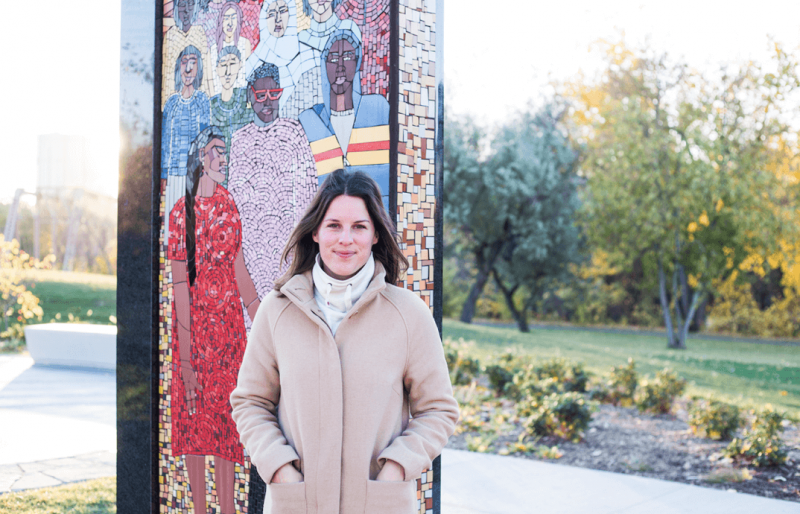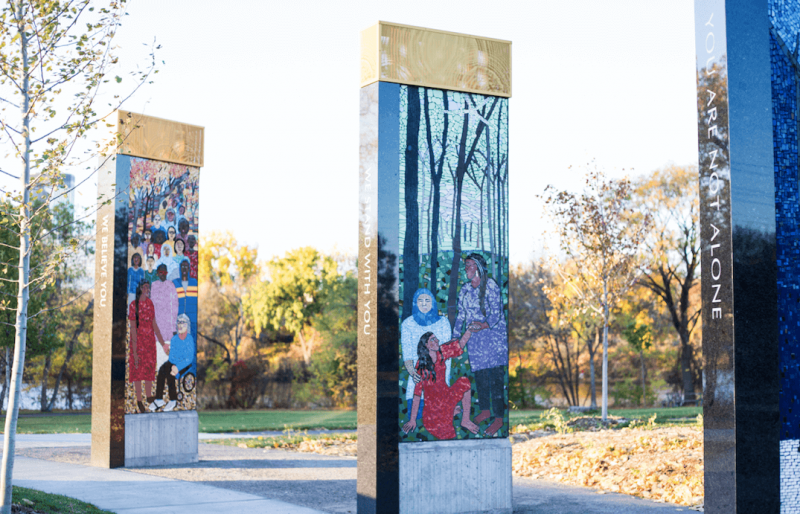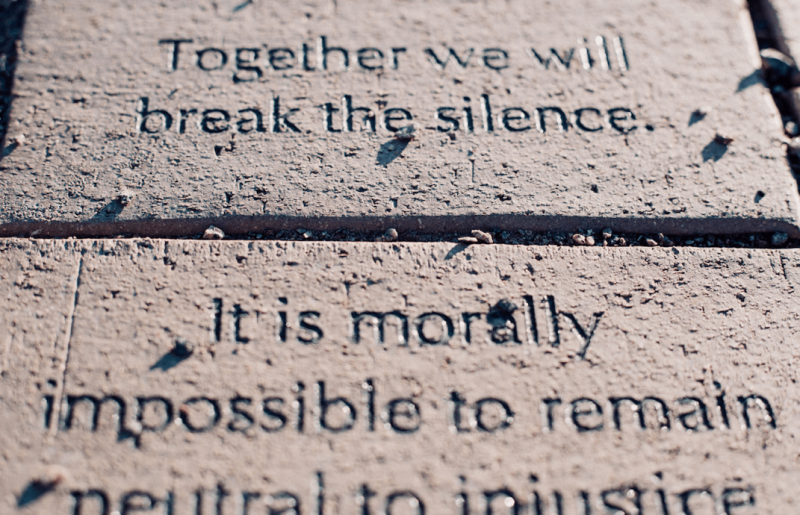Against the backdrop of the Minneapolis skyline, three mosaic pillars stand tall on what was once Dakota land. They are inscribed with 11 words: We believe you. We stand with you. You are not alone.
This is the first permanent memorial in the U.S. dedicated to survivors of sexual violence. It’s an undertaking Sarah Super began in 2015, just six weeks after being sexually assaulted at knifepoint by her ex-boyfriend, who hid in a closet — waiting — for 12 hours.
But Super’s story doesn’t start with her rape.
“Everything that I did — and the person I was before this happened to me — has contributed to everything I've done in the aftermath,” Super said.
After college, where she studied sociology and social justice, Super facilitated conversations about racism and white privilege. She went back to school to study the intersection of human rights abuses and how traumatic experiences impact the way we see the world and the way we behave.
This educational background gave Super a unique understanding of trauma even before her sexual assault, which, in part, enabled her to begin organizing so quickly in the aftermath.
“So, when I was raped, I had this body of knowledge of what it meant to organize, and social movements, and [how to use] education as a tool for social change,” she said.
sarah_super_memorial.png

It takes a village
While initiated and led by Super, creating the first-of-its-kind memorial was a community effort.
“It took a ton of people,” she said. “It took elected officials. It took architects and mosaic artists. I heard a lot of survivors giving input. It took probably somewhere around 1,500 donors.”
Community plays a unique role in healing from trauma, and when it comes to sexual violence, community has a mandate to participate, Super said.
“For far too long, the suffering of sexual violence victims and survivors has been forced into the shadows,” Super said in her dedication ceremony speech in early October. “This memorial brings our suffering into the light, where we, as a community, courageously choose to see it.”
Super often cites the work of Judith Herman, M.D., as one of the inspirations for the memorial.
In her 1992 book Trauma and Recovery, Herman wrote, “The most common trauma of women remains confined to the sphere of private life, without formal recognition or restitution from the community. There is no public monument for rape survivors.”
That silence, and the burden of bearing trauma privately, is something Super experienced in the wake of her own rape.
“Silence will never be interpreted as support,” she said. “Silence is not a neutral response to sexual violence. So, in order to support victim-survivors, people have to do something and say something. This [memorial] is one symbol of our community's support and solidarity with victim-survivors.”
Taking up space
The memorial doesn’t just show solidarity with survivors, it celebrates them. And the fact that it takes up space in the community — in a public park — is intentional.
Tarana Burke, founder of the #MeToo movement, described it this way at the memorial’s dedication ceremony: “Survivors are often made to feel small, like we can’t take up too much space, like we shouldn’t take up too much space. That our stories take up too much space, that our bodies even physically take up too much space. ... We deserve space, and now we have that.”
Other heroes have memorials, and as Burke reminded ceremony attendees, surviving is no small feat. In fact, she said, survivors are heroes.
Taking up space in the community is important because healing requires social action, Super explained.
“We haven't yet gotten there with people who have experienced sexual violence,” she said. “People still want to put healing in these private spaces and say it's the victim’s responsibility. It's something that other people can walk away from.”
But community is central to this healing because the heart of trauma is disempowerment and disconnection, Super said, citing Herman.
Fragments of healing
The memorial displays themes of community through the scenes depicted by mosaic artist Lori Greene. In one mosaic, a fragmented woman grabs another woman’s hand to help her stand. In another, two women have an entire community standing behind them.
The choice of mosaic is meant to show that even broken pieces can be put together to create something whole and beautiful.
“Survivors challenge us to reconnect fragments, to reconstruct history, to make meaning of their present symptoms in light of past events,” Herman wrote in Trauma and Recovery.
A ripple effect pattern on the ground where the benches sit represents the multiplying power of breaking the silence. Each story told gives other survivors permission to tell theirs, and as Burke said, “You cannot tell the story of your trauma without telling the story of your survival.”
survivors_memorial-zoomed_out.png

The timing of the dedication ceremony, the weekend before Indigenous Peoples’ Day, was not lost on Super, who opened the ceremony with remarks about the memorial being on stolen land. She also honored those whose lives have been cut short by police violence.
“Our city is reeling from George Floyd's murder, and the murder of so many people. And these battles, these issues that we're confronting are not separate,” she said. “As we tear those symbols down, we're also building spaces that speak the truth and honor the victim-survivors, not the perpetrators and oppressors.”
Ripple effect
Two people, bundled up against a cold Minnesota morning, walked up to the memorial and stood silently while reading the inscription.
“Just seeing people take it in is incredible,” Super said. “I feel like it’s already working.”
Just a few days after the memorial’s dedication ceremony, a woman in Wisconsin reached out to Super. She had received the first set of approvals to build a similar memorial in her town.
“That these words and messages will get communicated to victim-survivors across the country and around the world,” Super said, gazing at the mosaics. “It's much bigger than this.”
break_the_silence.png

If you need support, please call The National Sexual Assault Hotline, 1-800-656-HOPE (4673), to be connected with a trained staff member from a sexual assault service provider.
Editor's Note: This article was updated to recognize the contribution of mosaic artist Lori Greene.
Got something to say about what you're reading? We value your feedback!







